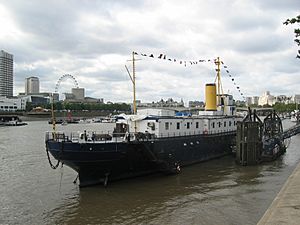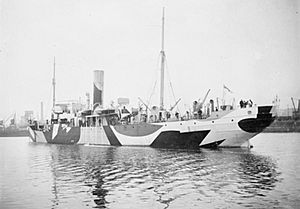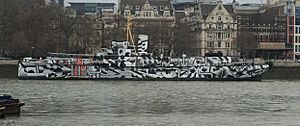HMS President (1918) facts for kids

HMS President in the Thames
|
|
Quick facts for kids History |
|
|---|---|
| Name | HMS Saxifrage |
| Builder | Lobnitz & Company, Renfrew, Scotland |
| Yard number | 827 |
| Launched | 29 January 1918 |
| Renamed |
|
| Fate | Sold, 1988; resold 2001 & 2006, sold in 2018 |
| Status | Conference venue and offices, awaiting dry dock |
| General characteristics | |
| Class and type | Anchusa-class sloop |
| Displacement | 1,290 long tons (1,311 t) |
| Length |
|
| Beam | 35 ft (10.7 m) |
| Draught | 11 ft 6 in (3.5 m) |
| Propulsion |
|
| Speed | 16 knots (30 km/h; 18 mph) |
| Range | 260 tons coal |
| Complement | 93 |
| Armament |
|
HMS President (1918), originally named HMS Saxifrage, is a special ship from World War I. She was launched in 1918 as a Flower-class Q-ship. A Q-ship was a warship disguised to look like a normal merchant ship.
In 1922, her name changed to HMS President. She was then permanently docked on the River Thames in London. For many years, she served as a training ship for the Royal Navy Reserve.
Later, in 1982, she was sold to private owners. Today, she is used for events, conferences, and as offices for different companies. The "(1918)" was added to her name to avoid confusion with another Royal Naval Reserve base called HMS President.
This ship is one of only three Royal Navy warships from World War I that are still around. She is also important because she was one of the first ships built specifically to hunt submarines. She helped lead to the design of modern anti-submarine ships called frigates.
Contents
Building a Secret Submarine Hunter
What is a Q-Ship?
HMS President was built as an Anchusa-type Flower-class sloop. These ships were made between 1916 and 1918. Their main job was to hunt submarines. They were designed to look like regular merchant ships. However, they had hidden 4-inch and 12-pounder naval guns.
During World War I, German submarines, called U-boats, would dive underwater if they saw a warship. To trick them, the British used Q-ships. These were merchant ships with hidden guns. The idea was that a U-boat captain wouldn't waste a valuable torpedo on a small merchant ship. Instead, they would surface to sink it with their own guns. When the U-boat got close, the Q-ship would reveal its hidden weapons and attack.
Clever Design for Tricking U-boats
By the time ships like Saxifrage were built, the Germans knew about Q-ships. So, these new sloops became active submarine hunters instead of just waiting to be attacked.
The builders used their existing designs for merchant ships, but added special features. For example, they had a fake rudder above the water. Below it was a much more agile balanced rudder. This allowed the ship to turn very quickly. A fast turn helped them aim their guns or drop depth charges (underwater bombs) on a U-boat. They could even try to ram a U-boat before it escaped.
Dazzling Camouflage
These ships were also painted with amazing dazzle camouflage patterns. These patterns were designed to confuse the simple range finders used by World War I submarines. It made it hard for the U-boat crew to figure out the ship's speed, direction, or even which way it was going!
In total, 120 Flower-class ships were built. Eighteen of them were sunk during the war.
Saxifrage was built in Scotland at the Lobnitz & Company shipyard. She was launched on January 29, 1918. Her name, Saxifrage, comes from a flower also known as London Pride.
A Long Life of Service
Fighting Submarines
HMS Saxifrage helped protect convoys (groups of ships) in UK waters during 1918. Her records show she engaged nine U-boats.
In 1922, she was permanently docked on the Thames and renamed President. Most other ships of her class were sold or scrapped before World War II. This allowed their names, like Saxifrage and Chrysanthemum, to be used again for new, smaller Flower-class ships called corvettes.
From 1922 onwards, HMS President was used as a training ship for the Royal Naval Reserve. She was docked permanently at Blackfriars on the Thames. Her new name came from an older ship, the Old President from 1829, which was the first naval reserve training ship in London.
The 1918 President served the Royal Navy for 70 years, from 1918 to 1988. She was the last Royal Navy warship to have the old-fashioned look of black hull, white upper parts, and a buff yellow funnel and masts. All naval personnel working in London were officially assigned to President for their pay and administration.
During World War II, President became a gunnery training ship. She was fitted with a large "shed" structure over her deck. Her main job was to train gunners for merchant ships that were armed for defense. Her sister ship, HMS Chrysanthemum, was docked next to her in 1938 to provide more office and training space.
After the war, both ships were rebuilt. They got larger deckhouses and extra offices. They also had tall wheelhouses and fake funnels that could be removed. This allowed them to pass under London bridges for maintenance in the dockyards. They continued as training ships until 1988.
Since 1988, the name HMS President is used for a shore base of the Royal Naval Reserve near Tower Bridge.
New Life as a Civilian Ship
A Charitable Home
In 1988, a charity called Inter-Action Social Enterprise Trust saved the ship from being scrapped. President became a base for new companies for young people, audio-visual studios, and a publishing company. It also had an "event deck" to earn money for the charity. This period saved the ship and helped preserve her for the future.
She had become a famous London landmark, even appearing on street maps. So, she was allowed to keep her warship title and name "HMS President" with the added "(1918)" to tell her apart from the new shore base. Her sister ship, Chrysanthemum, was used in the film Indiana Jones and the Last Crusade. Sadly, she later rusted badly and was scrapped in 1995.
A Place for Events and Offices
In 2001, President was sold again, and then in 2006, she was bought by MLS Group Plc. They wanted her to be a place for conferences and events, and to house offices for media companies. Her owners planned to highlight her history during the 2014-2018 World War I centenary. The U-boat campaign was a huge threat to Britain during that war.
As part of the Imperial War Museum's 14-18 Now project, HMS President was chosen to be a "dazzle ship". She was given a new paint job called Dazzle Ship London by artist Tobias Rehberger. This celebrated the artists who created the naval dazzle camouflage in World War I.
What's Next for HMS President?
President had been permanently docked on the River Thames in London since 1922. However, in 2016, she was moved to Chatham, Kent. This move was to make way for the building of the new Thames Tideway Tunnel.
Ownership of the ship was transferred to a charity. They tried to raise money for her restoration through crowdfunding and grant applications, but they were not successful.
In December 2018, HMS President (1918) was sold again. The new owner plans to dry dock and refurbish the ship. President turned 101 in 2019 and is still in Chatham. The new owners hope to bring her back to the Thames in the future.
She is still listed on the National Register of Historic Vessels as part of the National Historic Fleet.



